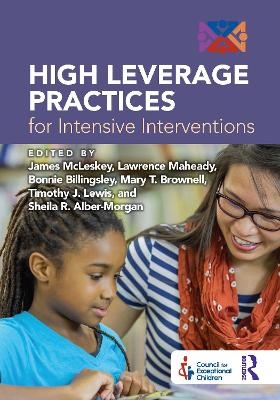
High Leverage Practices for Intensive Interventions
Routledge (Verlag)
978-1-032-23106-8 (ISBN)
James McLeskey is Professor in the School of Special Education, School Psychology, and Early Childhood Studies at the University of Florida, and project staff member for the CEEDAR Center. Lawrence Maheady is Professor and Horace Mann Endowed Chair in the Exceptional Education Department at SUNY Buffalo State. Bonnie Billingsley is Professor of Teaching and Learning at Virginia Tech. She teaches in both the teacher preparation and doctoral programs at Virginia Tech. Mary T. Brownell is a Distinguished Professor of Special Education at the University of Florida and Director of the Collaboration for Effective Educator Development, Accountability and Reform (CEEDAR) Center. Timothy J. Lewis is Curators’ Distinguished Professor of Special Education, Director of the University of Missouri Center for School-wide Positive Behavioral Interventions and Supports (PBIS). Sheila R. Alber- Morgan is Professor of Special Education at The Ohio State University and a Board Certified Behavior Analyst (BCBA- D). Her research focuses on using behavioral interventions to increase academic performance for individuals with disabilities.
Introduction Section I: Collaboration High Leverage Practices 1. Collaborate with Professionals to Iincrease Student Success 2. Organize and Facilitate Effective Meetings with Professionals and Families 3. Collaborate with Families to Support Student Learning and Secure Needed Services Section II: Assessment High Leverage Practices 4. Use Multiple Sources of Information to Develop a Comprehensive Understanding of a Student’s Strengths and Needs 5. Interpret and Communicate Assessment Iinformation with Stakeholders to Collaboratively Design and Implement Educational Programs 6. Use Student Assessment Data, Analyze Instructional Practices, and Make Necessary Adjustments that Improve Student Outcomes Section III: Social/Emotional/Behavioral High Leverage Practices 7. Establish a Consistent, Organized, Respectful Learning Environment 8. Provide Positive and Constructive Feedback to Guide Students’ Learning and Behavior 9. Teach Social Behaviors 10. Conduct Functional Behavioral Assessments to Develop Individual Student Behavior Support Plans Section IV: Instruction High Leverage Practices 11. Identify and Prioritize Long- and Short-term Learning Goals 12. Systematically Design Instruction Toward a Specific Learning Goal 13. Adapt Curriculum Tasks and Materials for Specific Learning Goals 14. Teach Cognitive and Metacognitive Strategies to Support Learning and Independence 15. Provide Scaffolded Supports 16. Use Explicit Instruction 17. Use Flexible Grouping 18. Use Strategies to Promote Active Student Engagement 19. Use Assistive and Instructional Technologies 20. Provide Intensive Instruction 21. Teach Students to Maintain and Generalize New Learning Across Time and Settings 22. Provide Positive and Constructive Feedback to Guide Students’ Learning and Behavior 23. Learning to Use HLPs for Intensive Interventions: Reflections for Teachers, School Leaders, and Teacher Educators
| Erscheinungsdatum | 17.07.2023 |
|---|---|
| Zusatzinfo | 55 Tables, black and white; 54 Line drawings, black and white; 54 Illustrations, black and white |
| Verlagsort | London |
| Sprache | englisch |
| Maße | 178 x 254 mm |
| Gewicht | 566 g |
| Themenwelt | Sozialwissenschaften ► Pädagogik ► Didaktik |
| Sozialwissenschaften ► Pädagogik ► Sonder-, Heil- und Förderpädagogik | |
| ISBN-10 | 1-032-23106-8 / 1032231068 |
| ISBN-13 | 978-1-032-23106-8 / 9781032231068 |
| Zustand | Neuware |
| Haben Sie eine Frage zum Produkt? |
aus dem Bereich


